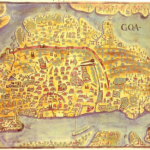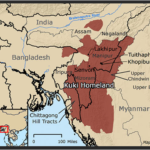“From Stettin in the Baltic to Trieste in the Adriatic, an iron curtain has descended across the Continent.”
Winston Churchill made this famous statement about the situation prevailing in the Euro-Asian region during the Cold War. The term Cold War was coined by Bernard Baruch however Walter Lipman popularized it through a series of articles.
Cold War: Nomenclature and definition
The term Cold War denotes the state of rivalry between the USA and USSR which led to the division of the world into two blocks. Towards the end of the Second World War, the harmony that had existed between the USSR, the USA and the British Empire began to wear thin and all the old suspicions came to the fore again. Relations between Soviet Russia and the West soon became difficult, although no actual fighting took place directly between the two opposing camps.
Both superpowers, the USA, and the USSR, gathered allies around them: between 1945
and 1948 the USSR drew into its orbit most of the states of Eastern Europe, as communist
governments came to power in Poland, Hungary, Romania, Bulgaria, Yugoslavia, Albania, Czechoslovakia, and East Germany (1949). A communist government was established in North Korea (1948), and the Communist bloc seemed to be further strengthened in 1949 when Mao Zedong was at last victorious in the long-drawn-out civil war in China. On the other hand, the USA hastened the recovery of Japan and worked closely with Britain and 14 other European countries, as well as with Turkey, providing them with vast economic aid to build up an anti-communist bloc.
Was the Cold War entirely Cold?
The Cold War was not entirely cold, it had its warm and hot phases. The Cold War and its implications have gone beyond the two countries, it has impacted almost every corner and nook in the globe. The worst affected regions have been Third-world countries. The third world became the ground for proxy wars between two superpowers such as: – Arab- Jewish wars, India-Pak wars, Korean war, Vietnam war, Afghanistan war etc.
However, according to American political scientist Kenneth Waltz, the deterrence of nuclear weapons played the role of coolant which ensured that the Cold War did not turn into a full-fledged hot war.
Perspectives on Causes of Cold War
It is a matter of debate among scholars and there are three different schools of thought to describe it
- Ideological reasons
- Geo-political reasons
- Social Constructivists
Ideological reasons
The Cold War was like any other war but it had a strong ideological dimension. It has been described as a war between ‘two ways of life’ i.e. The Communist system and The Capitalist system.
The communist system of organizing the state and society was based on the ideas of Karl Marx; he believed that the wealth of a country should be collectively owned and shared by everybody. The economy should be centrally planned and the interests and well-being of the working classes safeguarded by state social policies.
The capitalist system, on the other hand, operates based on private ownership of a country’s wealth. The driving forces behind capitalism are private enterprise in the pursuit of making profits, and the preservation of the power of private wealth.
Even the end of the Cold War is described as the victory of the liberal way of life over the communist way of life.
However, from the realist perspective ideologies carry no significance, they are just masks to hide the real intentions which was geo-politics.
Geo-political reasons
According to the realist scholars, the real reason is the contradictory geo-political interests i.e. geo-political aspirations of the USA and geo-political compulsions of Russia.
US foreign policy is guided by geopolitics (i.e. to maintain its hegemony) which has been influenced by the debate between Alfred T-Mahan (hegemony of sea power) and Halford Mackinder (hegemony of land power). Mackinder challenged the theory of Mahan and held that ultimately the world will come under the hegemony of land power. He called Europe+Asia+North Africa as a world island and countries like Russia, Iran and Eastern Europe constitute the heartland of world islands. Hence, for the USA to maintain its hegemony it has to prevent the integration of Eurasia and the rise of European power.
However, in the case of Russia, Geography determines its foreign policy, political system, and economy. Russia does not have the aim of establishing hegemony in the way the USA aims but it has a compulsion to expand its powers. In his book, The Revenge of Geography, Robert D Kaplan has explained how geography determines the fate of Russia. Russia does not have a natural defense. The Russian population and industrial sectors (Moscow, St Petersburg) are located just on the borders. Russian capital is not secured like other capital; hence Russia must have buffer states. Hence, Russia must expand and establish control on adjacent territory and by expanding it has potential to become a hegemon power which becomes contradictory to the interest of the USA.
Therefore, it is the compulsion of Russia and ideology has no role in the formation of the USSR and the USA knows that Russia is bound to expand its territories to reach the outland in the Baltic, Balkan, and Mediterranean Sea. Hence there is a possibility of Russia emerging as a transcontinental power which would adversely challenge US interests.
Realist scholars further add if it was ideology there would have been an end of rivalry post the end of cold war. However, incidents like the Crimean crisis and ongoing Ukraine war shows Russia is trying to expand east as the main reason is geo-politics.
Social Constructivists
Social constructivism is a school which has relatively recent origin specifically after the end of the Cold War and developed as a critique of realism. According to social constructivists, ‘All is in the mind’ i.e. our construction is shaped by our values, norms, and experiences; we continue with these constructions without making an attempt to verify. Nicolas Onuf (social constructivist scholar) has written a book titled THE WORLD OF OUR OWN MAKING on the eve of the end of Cold War. It shows that the Cold War was not inevitable. The Cold War was a result of miscalculations, misunderstandings which could have been avoided by having interaction and communication.



